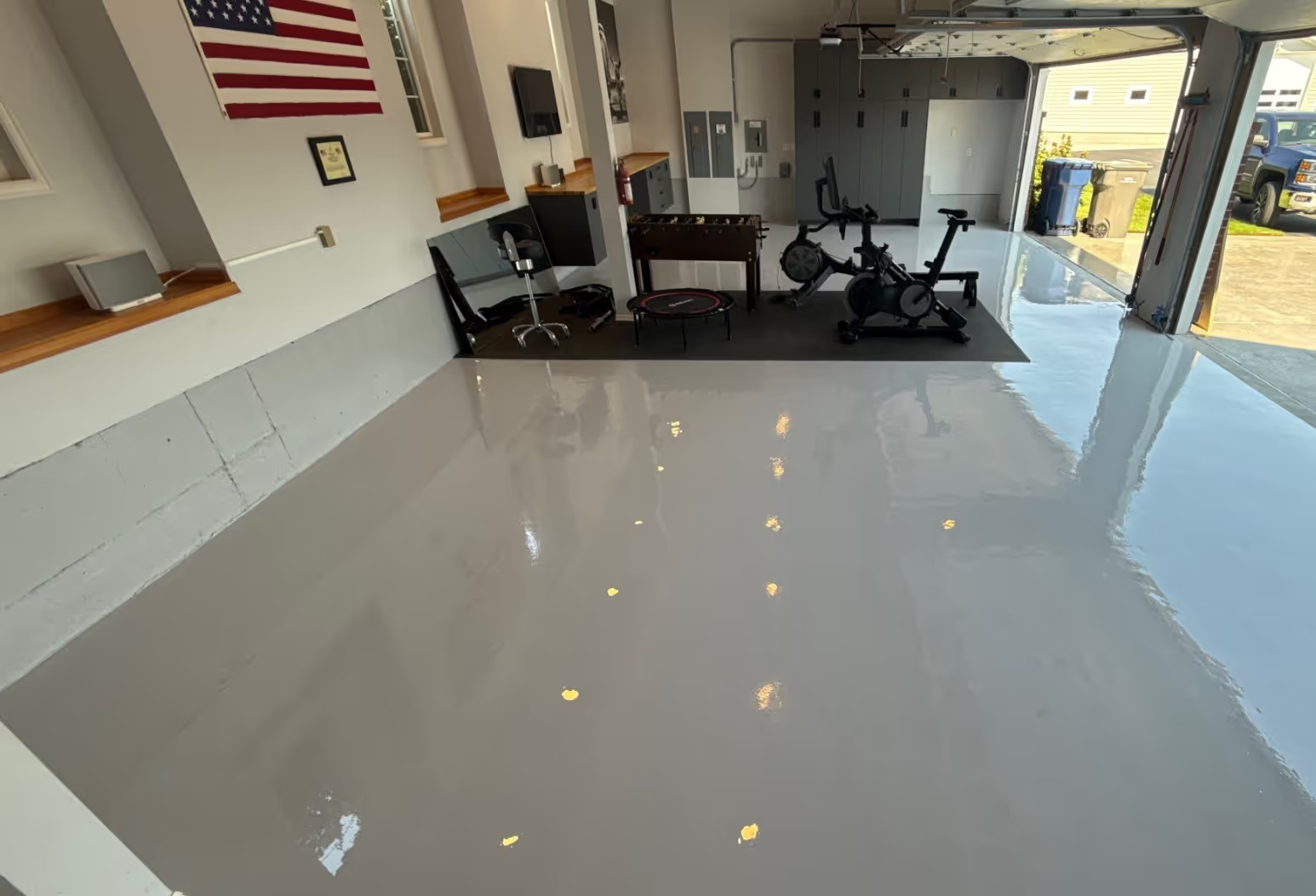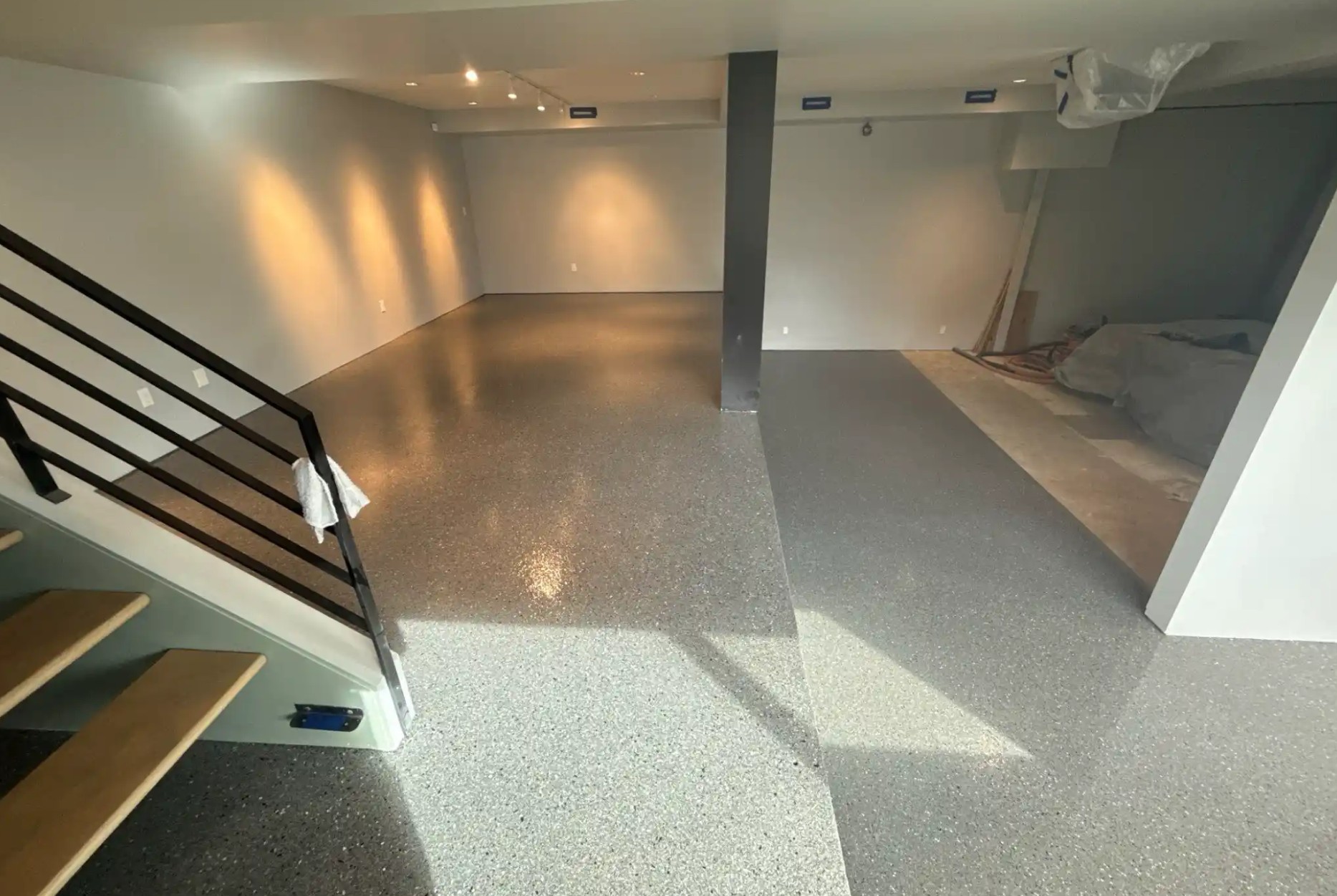
You've decided to transform your garage floor with a professional coating system. You're excited about the possibilities—the vibrant colors, the easy-to-clean surface, the showroom-quality finish. But as you survey your concrete, reality sets in: there are cracks. Some are hairline thin, others substantial enough to catch your shoe. And now you're wondering: can these cracks be fixed, or will they ruin your beautiful new floor?
Here's the truth that many coating companies won't tell you upfront: every crack is a potential weak point that can compromise your entire floor coating. The way these imperfections are addressed before coating application makes the difference between a floor that lasts 3-5 years and one that performs flawlessly for decades.
Understanding how to properly repair concrete cracks isn't just about fixing visible damage—it's about preventing the costly failures that plague homeowners who choose installers who cut corners or attempt DIY solutions without the proper expertise.
Before we dive into repair methods, it's essential to understand why proper crack treatment matters so much. When you apply a coating over untreated or poorly repaired cracks, you're essentially building on a compromised foundation.
The Physics of Coating Failure
Concrete is a dynamic material. It expands and contracts with temperature changes, shifts with ground movement, and experiences stress from vehicle weight and daily use. Cracks in concrete represent points where these forces have already caused structural movement.
When a coating is applied over an unrepaired crack:
This is why missed blemishes or improperly addressed cracks lead to broken seals, allowing moisture, water, and movement that ultimately ruin both the floor and its coating. A beautiful coating applied over poorly prepared concrete is simply expensive camouflage for inevitable failure.
Many homeowners discover the hard way that crack repair requires more than a tube of concrete patch from the hardware store. While DIY epoxy kits and concrete fillers seem like cost-effective solutions, they rarely deliver lasting results for several critical reasons.
Why DIY Repairs Often Fail:
Inadequate Surface Preparation: Most homeowners lack the specialized equipment needed to properly profile the crack edges and surrounding concrete. Without proper preparation, repair materials simply don't bond effectively.
Wrong Product Selection: Hardware store fillers and patching compounds aren't engineered for the dynamic stresses that garage floors experience. They lack the flexibility to move with the concrete and the adhesion strength to stay bonded long-term.
Improper Application Techniques: Professional crack repair involves specific techniques for cleaning, filling, and finishing that ensure the repair becomes a permanent part of the floor rather than a temporary patch.
No Moisture Management: DIY repairs rarely address moisture issues that often cause or worsen concrete cracks. Without solving the underlying moisture problem, the crack will continue to deteriorate.
Limited Warranty Protection: When you attempt DIY crack repairs before professional coating installation, you often void warranty coverage for the entire floor system—leaving you financially exposed if problems develop.
The money saved on DIY crack repair is quickly lost when the coating fails prematurely, requiring you to empty your garage again and pay for a complete floor replacement.
Successful crack repair requires a systematic, methodical approach backed by training, proper equipment, and proven techniques. This is where the expertise of Penntek Certified Dealers makes all the difference.
Before any repair work begins, professional installers conduct a thorough inspection of the entire concrete slab. This assessment identifies:
Not all concrete is the same. Each region uses different mixtures, building codes vary by decade, and each home's land, lot, and ground conditions create unique challenges. Professional assessment takes these factors into account, ensuring the repair approach matches your specific concrete's needs.
Once all imperfections are identified, the repair process begins with meticulous preparation:
Mechanical Profiling: Using specialized diamond tooling, installers create a mechanical profile along the crack edges. This profiling removes weak, deteriorated concrete and creates a clean, receptive surface for repair materials to bond.
Deep Cleaning: Professional equipment thoroughly cleans cracks of all dust, debris, oil, and contaminants that would prevent proper adhesion. This isn't just about surface cleanliness—it's about ensuring repair materials can penetrate and bond at the molecular level.
Moisture Testing: Before applying any repair materials, moisture levels are tested to ensure conditions are appropriate for application. Applying repair products over excessive moisture guarantees failure.
This is where professional repair dramatically differs from DIY approaches. Penntek Certified Dealers use specialized materials engineered specifically for concrete repair in coated floor applications:
Penntek Mender HD: This rapid-cure polyurea repair system represents a quantum leap beyond traditional concrete patching compounds. Key advantages include:
Expert application makes the difference between a repair that lasts and one that fails:
Proper Material Quantity: Overfilling or underfilling cracks creates weak points. Professional installers use precise techniques to ensure optimal material placement.
Complete Penetration: Repair materials must fully penetrate the crack depth, not just bridge the surface. Specialized application tools and techniques ensure complete filling.
Surface Finishing: Repairs are finished flush with the surrounding concrete, creating a uniform surface for coating application. This prevents stress concentrations that could cause future coating failure.
Adequate Cure Time: Even rapid-cure materials need appropriate time to achieve full strength before coating application. Rushing this process compromises the entire installation.
Crack repair is just one component of proper substrate preparation. For a coating to achieve its maximum lifespan and performance potential, the entire concrete surface must be meticulously prepared.
After crack repairs are complete, the entire floor undergoes professional grinding:
Heavy Equipment Makes the Difference: Professional floor grinders weigh over 600 pounds and use high-quality diamond tooling under extreme pressure to profile the concrete surface. This isn't something homeowners can replicate with rental equipment.
Proper Profile Depth: The grinding process creates the correct surface profile for optimal coating adhesion. Too shallow, and the coating won't bond properly. Too aggressive, and you weaken the concrete surface.
Hardness Adaptation: Concrete hardness varies significantly based on age, mixture, and curing conditions. Professional installers adjust grinding techniques to match your specific concrete's characteristics.
Surface contamination is a leading cause of coating failure. After grinding:
Industrial Vacuuming: Professional equipment removes all dust and debris created during the grinding process. Any residue left behind will interfere with coating adhesion.
Chemical Preparation: The substrate is chemically prepared to ensure optimal bonding conditions for the coating system.
Final Inspection: A comprehensive inspection verifies that all cracks are properly repaired, the surface profile is correct, and the concrete is ready for coating application.
The temptation to cut corners on crack repair is understandable—it's invisible work that gets covered up anyway. But this thinking leads to the most common and costly floor coating failures.
Why Proper Crack Repair Justifies Professional Installation:
When you factor in the true cost of coating failure—the time, hassle, and expense of emptying your garage again, the material costs, and the labor for a complete redo—professional crack repair delivers enormous value. A Penntek floor system that lasts 30-40 years costs far less over its lifetime than multiple cheap epoxy installations that fail every 3-5 years.
The standard of excellence maintained by the installation company, along with the engagement and rigor the team brings to their work day in and day out, drastically impacts the effectiveness of crack repair throughout the entire year. This is why choosing a Penntek Certified Dealer matters—you're getting installers who are trained, motivated, and held to certification standards that ensure they won't take shortcuts even when no one is watching.
Not all coating contractors prioritize proper crack repair. Here are warning signs that an installer may cut corners:
Here's a critical point that many homeowners and even some installers don't fully appreciate: the quality of crack repair directly impacts how well your coating system performs.
Chemical Bonding vs. Mechanical Bonding
Standard epoxy creates only a mechanical bond with concrete—essentially gripping the surface texture. When cracks move or moisture enters through poorly repaired areas, this mechanical grip fails.
Penntek's pure polyurea system creates a chemical bond at the molecular level with the concrete surface. This chemical bond is so strong that the concrete would break before the coating would separate. But this superior bonding can only occur when the substrate—including all crack repairs—is properly prepared.
If cracks aren't correctly repaired with compatible materials, you create weak points where even Penntek's superior chemistry can't compensate for poor substrate preparation.
Many concrete cracks are symptoms of moisture issues rather than just structural problems. Addressing the crack without addressing moisture is like treating symptoms while ignoring the disease.
Common Moisture-Related Issues:
Professional installers test for moisture issues before beginning work and have solutions for managing problematic moisture levels. This might include specialized primers, moisture mitigation systems, or—in severe cases—recommending that coating installation be delayed until moisture problems are resolved.
Attempting to coat over moisture-compromised concrete with unaddressed cracks is a recipe for expensive failure.
The difference between amateur and professional crack repair becomes obvious over time. Here's what you can expect from properly repaired cracks beneath a professional coating system:
Years 1-5: While DIY repairs and amateur installations begin showing signs of failure—cracking along the original repair lines, moisture intrusion, delamination—professionally repaired cracks remain invisible and stable.
Years 5-15: Improperly repaired cracks have usually caused complete coating failure by this point, requiring replacement. Professional repairs continue performing without issue.
Years 15-30+: Professional crack repair and coating systems continue protecting your concrete, while competitors have faced multiple costly reinstallations.
This dramatic difference in longevity is why Penntek can confidently offer a limited lifetime warranty on their coating systems. The warranty isn't just about the coating chemistry—it's about the complete installation process, including meticulous crack repair that creates a foundation for decades of performance.
If you're serious about getting a garage floor that will last, crack repair deserves the same attention as coating selection and color choice. The most beautiful coating applied over poorly repaired concrete is simply an expensive countdown to failure.
Questions to Ask Potential Installers:
Professional contractors will have detailed answers to these questions and will often provide photo documentation of their repair work.
If you're ready to transform your garage with a coating system that's built to last, the first step is a professional assessment of your concrete's condition, including all cracks and imperfections.
Penntek Certified Dealers provide complimentary consultations that include thorough concrete inspection, detailed explanations of repair requirements, and transparent pricing that reflects the true scope of work needed to deliver a lifetime floor.
Don't let inadequate crack repair compromise your investment. Choose installers who understand that proper preparation—including meticulous crack repair—is the foundation of coating systems that perform for decades.
Key Takeaways:
Ready to get started? Contact us today for a free consultation and discover how proper crack repair and professional installation create garage floors that last a lifetime.
Transform your cracked concrete into the showroom-quality floor you've always wanted—built on a foundation of expert crack repair and meticulous preparation that ensures decades of beautiful, trouble-free performance.





